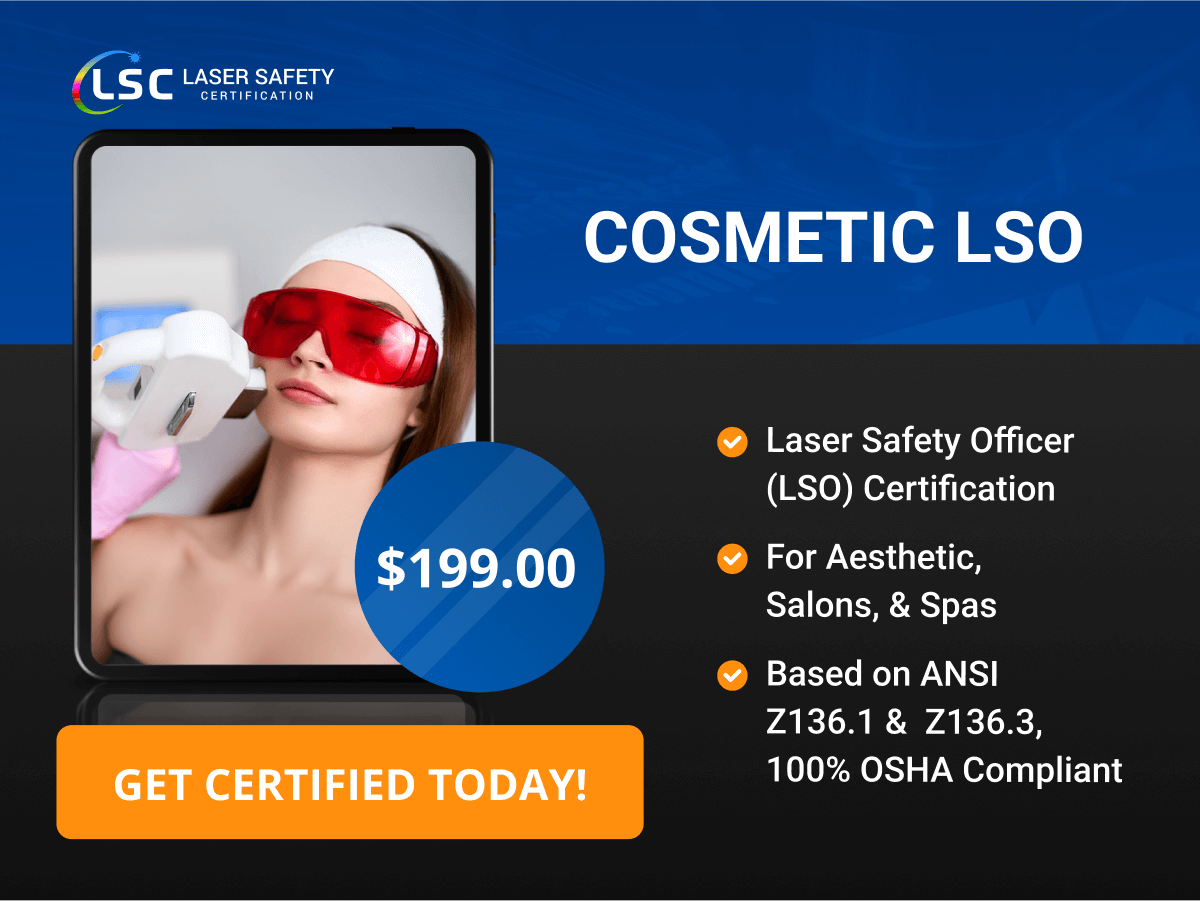Cosmetic Laser Safety Officer Certification
What are the requirements to become a Cosmetic/Aesthetic LSO?
Cosmetic LSO Certification - $199
With our curriculum, you will become the in-house expert in the following:
- How Lasers Work
- Scientific Terms
- Hazard Evaluation
- Control Measures
- Medical Examinations
- Non-Beam Hazards
- Eye & Skin Exposure
- Hazard Classification
- Environmental Controls
- Protective Equipment
- Warning Signs
- Laser Generated Airborne Contaminants
- Secondary Radiation
- Fire Hazards
What type of cosmetic laser devices require safety training?
In the field of cosmetic laser procedures, various types of laser devices are used for treatments such as hair removal, skin resurfacing, tattoo removal, and more. These devices vary in their potential hazards, and appropriate safety training is required to ensure safe use. Here are the main types of cosmetic laser devices that require safety training:
Types of Cosmetic Laser Devices Requiring Safety Training
Laser Hair Removal Devices (Class 3B and Class 4)
- Hazards: These lasers pose risks of skin burns and eye injuries due to their high power output.
- Safety Training: Operators must be trained in the safe use of the device, including understanding the specific wavelengths used, potential skin reactions, and the importance of eye protection.
Laser Skin Resurfacing Devices (Class 3B and Class 4)
- Hazards: These lasers can cause significant skin damage and pose a high risk to the eyes.
- Safety Training: Training should cover the principles of laser-tissue interaction, safe operating procedures, patient preparation, and the use of protective eyewear.
Tattoo Removal Lasers (Class 3B and Class 4)
- Hazards: High-energy pulses can cause skin damage and ocular hazards.
- Safety Training: Operators need to understand the specifics of different wavelengths used for tattoo removal, skin response, and how to protect both the patient and the operator’s eyes.
Laser Treatment for Pigmented Lesions and Vascular Lesions (Class 3B and Class 4)
- Hazards: These treatments involve high-intensity lasers that can cause thermal damage to the skin and eyes.
- Safety Training: Training includes understanding the laser-tissue interaction, correct device settings, patient safety measures, and proper use of eye protection.
Fractional Lasers (Class 3B and Class 4)
- Hazards: These devices can cause burns and eye injuries due to their high power and ability to deeply penetrate the skin.
- Safety Training: Operators must be trained in the use of fractional lasers, including safe operation techniques, skin response management, and eye protection protocols.
Non-Ablative Laser Devices (Class 3B and Class 4)
- Hazards: While less invasive, these lasers still pose risks of skin and eye injuries.
- Safety Training: Training should cover the safe operation of non-ablative lasers, patient safety, and the importance of using protective eyewear.
Key Components of Safety Training for Cosmetic Laser Devices
Laser Physics and Tissue Interaction
- Basic understanding of how lasers work and their effects on different types of tissue.
- Specific training on the wavelengths and energy levels used in cosmetic procedures.
Regulatory and Standards Compliance
- Knowledge of relevant ANSI standards (e.g., ANSI Z136.3 for healthcare) and OSHA regulations.
- State-specific regulations and guidelines for cosmetic laser use.
Hazard Identification and Risk Assessment
- Identifying potential hazards associated with specific cosmetic laser devices.
- Conducting risk assessments and implementing appropriate control measures.
Safe Operating Procedures
- Detailed training on the correct operation of cosmetic laser devices.
- Procedures for patient preparation, device calibration, and post-treatment care.
Use of Personal Protective Equipment (PPE)
- Ensuring all personnel and patients wear appropriate protective eyewear.
- Using other PPE such as gloves and protective clothing as necessary.
Emergency Procedures
- Training on how to respond to laser-related accidents and injuries.
- First aid measures and emergency response protocols.
Patient Safety and Communication
- Educating patients on the risks and safety measures of laser treatments.
- Ensuring patients understand post-treatment care and potential side effects.
Record Keeping and Documentation
- Maintaining accurate records of training, equipment maintenance, and safety incidents.
- Documenting patient consent and treatment details.
Summary
Safety training is essential for anyone operating or assisting with cosmetic laser devices, especially those classified as Class 3B and Class 4. These devices include laser hair removal systems, skin resurfacing lasers, tattoo removal lasers, and others used for treating pigmented and vascular lesions. Training should cover laser physics, regulatory compliance, hazard identification, safe operating procedures, use of PPE, emergency response, patient safety, and record keeping to ensure the safe and effective use of cosmetic lasers.
